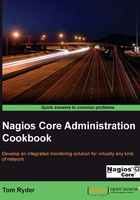
What this book covers
Chapter 1, Understanding Hosts, Services, and Contacts, explains the basic building blocks of Nagios Core configurations and how they interrelate, and discusses using groups with each one.
Chapter 2, Working with Commands and Plugins, explains the architecture of plugins and commands, including installing new plugins, defining custom uses of existing ones, and walks us through for writing a new plugin with Perl.
Chapter 3, Working with Checks and States, explains how Nagios Core performs its checks and how to customize that behavior, including scheduling downtime for hosts and services, and managing "flapping" for hosts or services that keep going up and down.
Chapter 4, Configuring Notifications, explains the logic of how Nagios Core decides on what basis to notify, and when and to whom, including examples of implementing a custom notification method, escalating notifications that aren't fixed after a certain period of time, and scheduling contact rotation.
Chapter 5, Monitoring Methods, gives examples of usage of some of the standard Nagios Plugins set, moving from basic network connectivity checks with PING and HTTP to more complex and powerful checks involving SNMP usage.
Chapter 6, Enabling Remote Execution, shows how to use NRPE as a means of working around the problem of not being able to check system properties directly over the network, including a demonstration of the more advanced method of check_by_ssh.
Chapter 7, Using the Web Interface, shows some less-used features of the web interface to actually control how Nagios Core is behaving and to see advanced reports, rather than simply viewing current state information. Use of the network map is not discussed here but in the next chapter.
Chapter 8, Managing Network Layout, explains how to make Nagios Core aware of the structure and function of your network, with a focus on hosts and services depending on one another to function correctly, including monitoring clusters, and using that layout information to build a network status map, optionally with icons and a background.
Chapter 9, Managing Configuration, shows how to streamline, refine, and control Nagios Core configuration at a low level without the use of frontends. It focusses on the clever use of groups, templates, and macros, and gives an example of generating configuration programmatically with the templating language m4.
Chapter 10, Security and Performance, shows how to manage simple access control, debugging runtime problems, and keeping tabs on how Nagios Core is performing, as well as a demonstration of basic monitoring redundancy.
Chapter 11, Automating and Extending Nagios Core, explains how to submit check results from other programs (including NSCA) to provide information about external processes via the commands file, and an introduction to a few popular add-ons (NDOUtils, NagVis, and Nagiosgrapher).